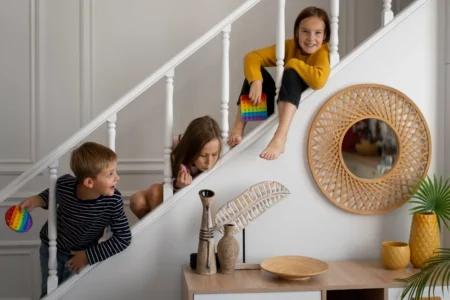 In today’s world, creating a child-friendly home interior design is essential. It’s not just about aesthetics but also about ensuring your children’s safety, comfort, and overall well-being.
In today’s world, creating a child-friendly home interior design is essential. It’s not just about aesthetics but also about ensuring your children’s safety, comfort, and overall well-being.
Today, we will explore some key tips and subheadings to help you achieve a child-friendly home interior design.
1. Choosing Safe and Durable Furniture
When designing a child-friendly home, start with selecting furniture that’s safe for kids. Opt for rounded corners on tables, and chairs, and avoid furniture with sharp edges. Additionally, choose durable, easy-to-clean materials like leather or microfiber that can withstand the wear and tear of an active child.
2. Kid-Friendly Colors and Themes
Incorporate child-friendly colors and themes into your interior design. Bright, cheerful colors and playful themes can stimulate a child’s creativity and make their living spaces more inviting.
3. Childproofing Your Space
Safety is paramount. Childproof your home by securing heavy furniture to the wall, covering electrical outlets, and installing safety gates if needed. Make sure your child can explore without encountering potential hazards.
4. Create Functional Play Areas
Dedicate specific areas for play and learning. A playroom or a corner with educational toys can help keep your child engaged and organized. This allows them to have a space where they can learn and grow.
5. Storage Solutions
Children come with lots of stuff. Invest in smart storage solutions to keep the clutter at bay. Toy chests, wall shelves, and storage bins are excellent choices to keep things organized.
6. Comfortable and Safe Flooring
Select flooring that is comfortable for your children to play on and easy to clean. Carpets are soft but can trap allergens, while hardwood or laminate flooring is easy to maintain and provides a smooth surface for play.
7. Child-Sized Furniture
Consider including child-sized furniture in your design. Miniature chairs and tables can make your child feel like a part of the home while encouraging independence.
8. Personalization
Allow your child to personalize their space with their artwork or favorite decorations. This promotes creativity and a sense of ownership.
9. Natural Light and Ventilation
Ensure that your child’s space has plenty of natural light and proper ventilation. A well-lit and airy room can improve their mood and overall well-being.
10. Family-Friendly Spaces
Design your home with spaces where you can spend quality family time. A cozy living room or a spacious dining area can encourage bonding and create lasting memories.
Designing a child-friendly home interior is a balance between aesthetics, safety, and functionality. By incorporating these subheadings, you can create a welcoming environment that nurtures your child’s growth and development while also reflecting your personal style.
Picture Credit: Freepik



